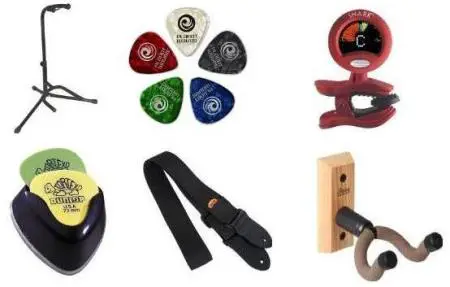 Guitar Accessories for Acoustic, Electric, Bass Guitars: While guitars like picks, strings and gig bags are quite obvious, there are a few other useful accessories that you are likely to require. Guitar accessories makes learning to play the acoustic or electric guitar easier, makes you more comfortable while playing, and your guitar sounds more interesting.
Guitar Accessories for Acoustic, Electric, Bass Guitars: While guitars like picks, strings and gig bags are quite obvious, there are a few other useful accessories that you are likely to require. Guitar accessories makes learning to play the acoustic or electric guitar easier, makes you more comfortable while playing, and your guitar sounds more interesting.
So Many Accessories to Choose From
If you check out any Guitar store, you will be amazed to see the wide range of Guitar Accessories, but you don’t need all of them at one go.
Besides, some accessories are optional – you really don’t have to have them.
For example, Straps and picks are both optional. You will need a strap only if you want to play live, whereas a pick isn’t required if you want to play slap bass or finger style bass.
Tuners are required so that your guitar produces the right sounds from the strings.
A cable will be necessary if you have an amplifier, which is required for playing electric bass, and even then only if you plan to play live.
Useful But Not Mandatory
Some accessories like amplifiers, strap locks, and locking tuners may not be required for someone who’s just starting out on the guitar.
Amps are required if you plan to gig or jam with friends. For personal use, you may not need an amp (although you do get smaller sized practice amps as well).
Strap locks protects your bass guitar from nasty falls, if your strap breaks (which is rare, but may happen). So, its useful for gigging musicians.
Locking tuners don’t do much besides keep your strings from slipping. This doesn’t necessarily mean that they will help you to stay in tune any better (they simply clamp the strings), but they can possibly help.
Accessories to Enhance Your Sound
Pedals, effects, are the more flashy accessories, which better suits the more experienced players.
Wah pedals, distortion pedals, chorus pedals, lights, stickers looks good on stage, and even in the studio. Basically, these are best suited for performers and music producers.
For beginners, a little bit of practice will do you a whole lot better than immediately grabbing the wah pedal.
Must-Have Accessories for a beginning Guitar Player
Accessories are equipment that provides safety to your music instrument, helps to move them around, and can also help to make your instrument sound better. Some of the popular ones include gig bags / cases, guitar straps, stands, cables, tuners, and so on.
Essential Guitar Accessories for Acoustic, Electric, Bass Guitars
Here are some essential guitar accessories that you would need in case you own acoustic, electric, or bass guitars.
These are not in any particular order of importance but every guitarist, beginner or experienced, should have this as part of their essential music gear accessories.
Soft Guitar Cases / Gig Bags
A guitar has several fragile parts and can be damaged when you take it to for music classes, or to the college, for gigs/practice session. One fall or a knock/brush against a wall can cause scratches or dents to the wooden shell of the guitar.
You need a soft guitar case (gig bag) for general protection and convenience. These padded bags offer protection to your guitar as you move it from one place to another; The padding prevents scratches and dents to the guitar. Zipped pockets lets you carry things like picks, strings, tuners, sheets, books. A shoulder strap makes it easy to carry the guitar in the gig bag.
If you live in a dusty area, you’ll need to occasionally clean/dust your guitar case, you may even use a slightly damp cloth to clean the soft case.
However, if you have a high end professional guitar, you should consider buying a hard-shell case (professionals use it all the time).
- Chroma Cast Padded Acoustic Guitar Bag: Soft case with storage option. 6 exterior pockets. Handle, guitar strap, bakcpack straps.
- Cahaya 41 inch Acoustic & Classical Guitar Gig Bag: Soft case with storage options. Shoulder strap and carry handles.
- Leather Gig Bag for Full Size Acoustic Guitar Classical Guitar: Great for performing musicians.
- Gator Cases Transit Series Acoustic Guitar Gig Bag: Weather resistant, quality product, better protection
Guitar Tuners
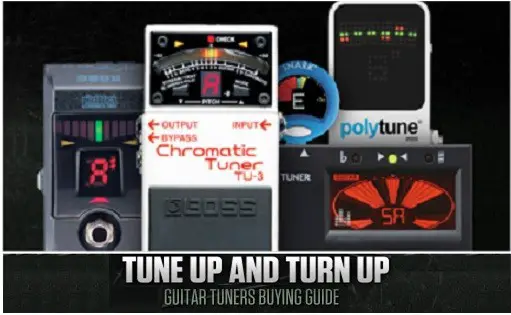 String instruments need to be tuned regularly in order to get the right tones from them. A guitar is tuned by turning the pegs on the headstock of the guitar. A guitar tuner makes it easy to tune a string instrument (guitar, bass, ukulele) and is available in various types ranging from chromatic tuners to self-tuning guitars.
String instruments need to be tuned regularly in order to get the right tones from them. A guitar is tuned by turning the pegs on the headstock of the guitar. A guitar tuner makes it easy to tune a string instrument (guitar, bass, ukulele) and is available in various types ranging from chromatic tuners to self-tuning guitars.
How Do the Tuners Work?
The electronic ones come with a microphone that detects and measures the frequency of the notes played on the guitar. The most widely used tuning for guitars is the “standard tuning” of E-G-B-D-A-E. Each of these notes has a specific frequency associated with it, which is detected and identified by the tuner, which is then compared to the standard reference tuning frequencies.
A tuning fork is generally used as a source of reference. So the guitarist would first listen to the tuning fork and then try to play the same note on the guitar. When they are in sync, the guitar is tuned to that particular note.
Most tuners are chromatic tuners; a chromatic tuner is a device that can tune any note, including sharps and flats, and it’s tuning range covers all the 12 notes of the scale.
Guitar Tuners are available in various styles:
Pedal tuners
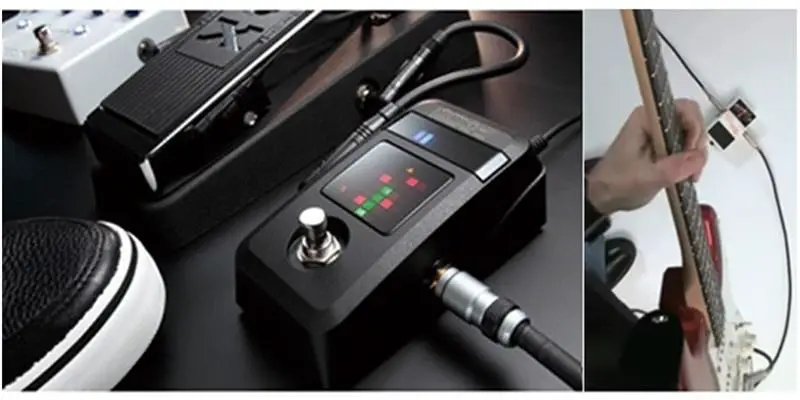 These are placed under the feet and are best suited for players who wish to tune during a live performance. A popular model is the Boss TU-3 Chromatic pedal tuner that is ruggedly built and has an indicator that suggests your tuning is complete.
These are placed under the feet and are best suited for players who wish to tune during a live performance. A popular model is the Boss TU-3 Chromatic pedal tuner that is ruggedly built and has an indicator that suggests your tuning is complete.
Clip-on or headstock tuners
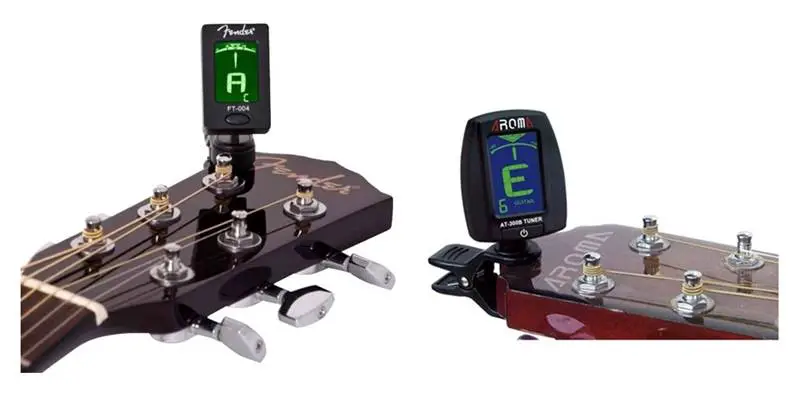 These are popular, in general, among guitar players. It comes in handy especially when playing live as you can quickly re-tune the strings between songs, if you feel the need. These tuners check the tuning based on the vibrations of the strings. These are affordable, do not require a separate power source (work on batteries). The Snark SN-1 guitar and bass tuner is a popular model that is convenient to use and gives precise results. Use it on the front or back of your headstock, depending on whether you’re left- or right-handed.
These are popular, in general, among guitar players. It comes in handy especially when playing live as you can quickly re-tune the strings between songs, if you feel the need. These tuners check the tuning based on the vibrations of the strings. These are affordable, do not require a separate power source (work on batteries). The Snark SN-1 guitar and bass tuner is a popular model that is convenient to use and gives precise results. Use it on the front or back of your headstock, depending on whether you’re left- or right-handed.
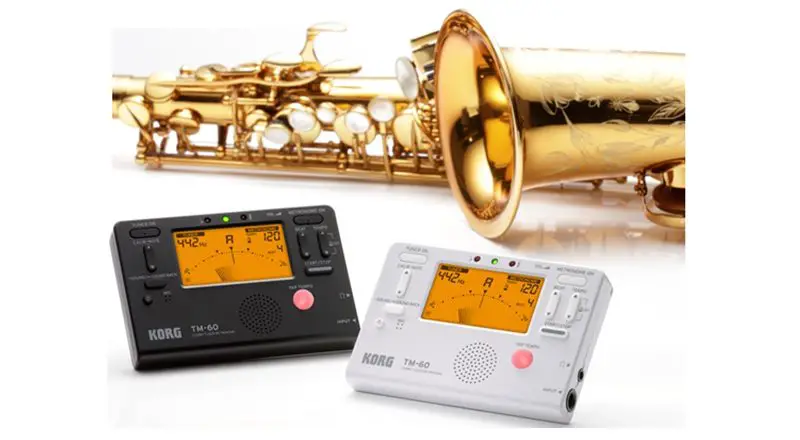 Hand-held Tuners are accurate, cheaper and smaller in size. You get models with built-in microphone which allows them to be used for tuning other instruments as well.
Hand-held Tuners are accurate, cheaper and smaller in size. You get models with built-in microphone which allows them to be used for tuning other instruments as well.
Best Clip-on Tuners:
- Snark SN-5 (Budget): Inexpensive, accuracy up to +/- 1 cent. Powered by a single CR2032 battery.
- Peterson StroboClip (Premium): Far better build quality and accuracy (compared to the above two tuners). Accuracy up to +/- 0.1 cent (ten times better than most tuners). The body is all metal, and it feels like a premium tuner.
Best Pocket Tuners:
- Korg GA-40 (Budget)
- Korg TM-60 (Best Value): tuner and metronome
- Boss TU12-EX (Premium)
Best Pedal (Stage) Tuners:
- Korg Pitchblack (Budget)
- Boss TU-3 (Premium)
Electronic tuner
Korg GA1 Guitar and Bass Tuner
Lets you select either Guitar mode or Bass mode for easy operation with automatic pitch detection. The GA-1 Bass Tuner mode support 6-string basses (Low-B, Hi-C). A high-sensitivity mic is built-in, allowing easy and accurate tuning of acoustic guitars.
Make sure you have a tuning fork handy, in case the batteries in your electronic tuner dies.
Snark Tuners
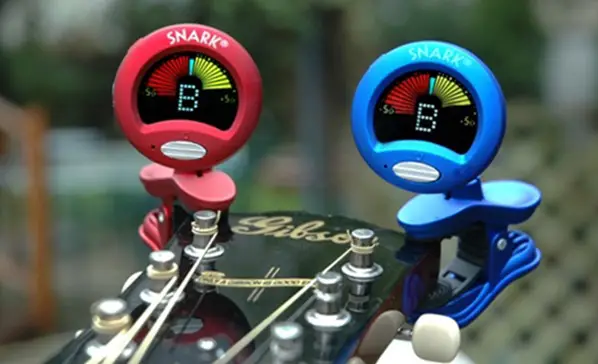 Snark produces a wide range of tuners, including chromatic ones, and some of them can be used for multiple stringed musical instruments, besides guitar & bass.
Snark produces a wide range of tuners, including chromatic ones, and some of them can be used for multiple stringed musical instruments, besides guitar & bass.
Snark tuners are simple to use, they are smaller and portable, they are accurate, they work with most stringed instruments, their battery lasts longer, and their rubber paddings don’t leave any mark on the guitar.One of their most popular tuning gadget is the clip-on tuner!
Snark tuners require little CR 2032 lithium watch batteries. It’s best to have some spare ones so that you are not left stranded when you need one. Energizer is one good brand that you can use, though it’s not the only one to choose from.
Guitar Strings
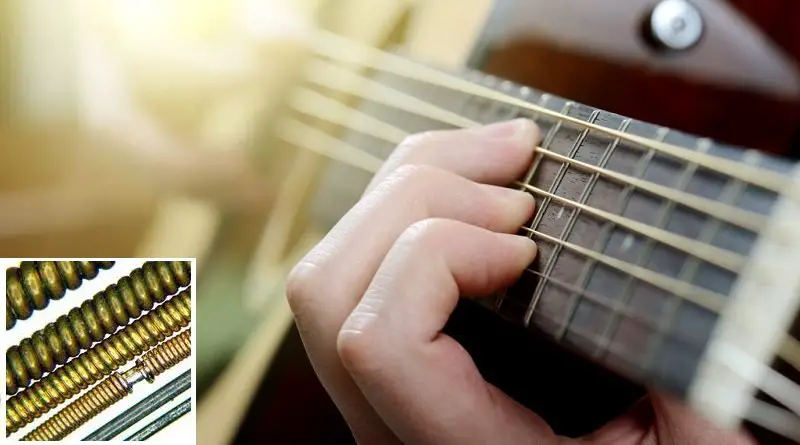 Every guitar player needs spare strings as they break, or become dull over a period of time, or because the original guitar itself came with poorer set of strings.
Every guitar player needs spare strings as they break, or become dull over a period of time, or because the original guitar itself came with poorer set of strings.
Guitar strings are made of different materials, the more common ones being nylon and steel. However, Guitars strings are made from other materials as well.
Here are some important points to remember when it comes to Guitar Strings:
- Nylon produces a round, mellow sound and is the preferred sound for playing classical music
- Strings, in general, can have low, medium, normal and hard tension
- Less string tension makes a classic guitar easier to play
Some of the popular options for strings are:
- Bronze (80% of copper to 20% of zinc or tin): Produces bright sounds with clear ring, but not very durable.
- Phosphor and bronze acoustic (92% to 8% or 85% to 15%): The bronze makes the sound brighter, more durable as good resistance to corrosion, preferred by most players.
That is why those acoustic strings don’t actually look steel colored.
Bronze produces a “bright” sound, steel can be softer especially when wrapped in nickel, and nylon is much more mellow.
Strings for electric guitar are usually made from Stainless steel, Nickel (or Nickel coated ones).
Steel strings are quite popular because of the brilliant tone and great volume. They also last longer than their nickel plated counterparts. Drawback is that the fingers make noise when played on their rough surface
Nickel plated strings add nickel to subdue the tones to produce a softer/rounder sound. It is also smoother on the fingers which eliminates the finger noise and improves playability. That is the reason many guitarists prefer these. Jazz musicians and rhythm guitarists prefer these over stainless steel.
Ernie Ball Guitar Strings
Ernie Ball guitar strings are quite popular among students and players. The Super Slinky line of electric guitar strings have been around since the sixties.
D’ Addario Guitar Strings
D’ Addario is another popular manufacturer of guitar strings. Most guitar players think that the feel and sound of D’Addario guitar strings, especially the Phosphor Bronze, is very good. Anyone who wants the best and doesn’t mind spending a bit more, should consider these.
Quality of sound produced by guitar strings depend on the material used and gauge/thickness of the strings.
- Thin Gauge: Easier to bend, preferred by beginners
- Medium / Heavy gauge: Produces more volume, preferred by rhythm guitarists for the sheer volume and full sound produced
- You have options of light, super light, extra super light, medium, heavy and extra heavy gauges.
Beginners should ideally choose the lighter guitar strings as they are easier to play, and hurt less. However, the thinner strings don’t sound as loud, full, and bright as the heavier/thicker ones though. The thicker ones are good for strumming but require more strength, and that is why the experienced players use it more.
Usually, thicker and stronger strings are used for the lower registers so that they can make bassy sounds. Thinner strings, on the other hand, are used for the upper octaves / registers to produce a higher pitch. Though thicker strings do sound louder, they need to be played harder and the pressure required to push the strings down is much more, compared to the thinner ones.
You can choose from a variety of gauges, and materials such as silver, nylon, steel, bronze, and nickel guitar strings. Most strings are also made from alloy of different metals so that you get the best qualities of those individual metals.
So if you see something like 80/20 written on the packet of the guitar strings, it means it uses a combination of two metals, with the first metal making 80 percent of the alloy and the remaining 20% of the other metal.
Guitar Picks
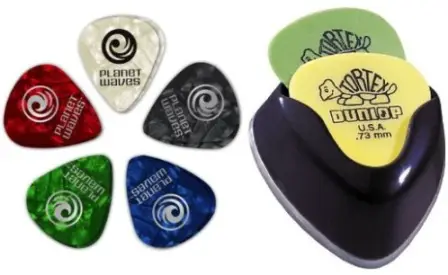 A guitar pick is a plectrum used for strumming guitars, and is quite helpful to learn strumming, especially when you are a beginner. These are available in a wide variety of shapes, colors and thicknesses. Most guitar players try out various makes and then stick to something that they are comfortable playing with.
A guitar pick is a plectrum used for strumming guitars, and is quite helpful to learn strumming, especially when you are a beginner. These are available in a wide variety of shapes, colors and thicknesses. Most guitar players try out various makes and then stick to something that they are comfortable playing with.
A pick is generally made of one uniform material; such as plastic, nylon, or celluloid. The better ones do help to an extent to provide a natural feel and warm, fat tone.
- D Addario Assorted Pearl Celluloid Guitar Picks, Medium
- Fender Premium Picks Sampler – Pack Includes Thin, Medium & Heavy Gauges
- Dunlop 5005 Scotty’s Pickholder
You may even choose to go in for a guitar pick holder, which is quite convenient to keep these picks, once you are done playing.
The best part is that there are pick holders which easily attach to the guitar itself, so you don’t have to worry about losing anything.
The little adhesive strip on the holder keeps it glued to the guitar, and peels off easily without ruing the finish of the guitar.
Guitar Foot Stool
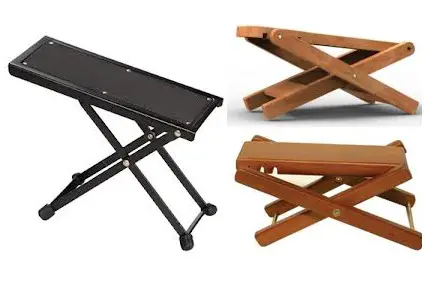 A guitar foot rest is used by the majority of classical and the Flamenco musicians. A foot rest is height adjustable and easily foldable. It lets you raise your leg while sitting for fatigue free guitar playing. The better ones are more sturdily built and stay in place.
A guitar foot rest is used by the majority of classical and the Flamenco musicians. A foot rest is height adjustable and easily foldable. It lets you raise your leg while sitting for fatigue free guitar playing. The better ones are more sturdily built and stay in place.
- Tetra-Teknica Essentials Series GFR-01 Guitar Foot Rest: Inexpensive. Height Adjustable. Rubber feet to prevent the foot rest from sliding and protects floors.
- On Stage Guitar Foot Rest: From a trusted brand, this solid foot rest is perfect for all guitarists – beginners as well as experienced players (popular with classical and studio electric players). Height adjustable (5 fixed height positions: Highest position is 11 inches and lowest is about 5 inches). Non-slip rubber pad prevents slipping.
- K&M Stands Foot Rest: A nice, sturdy and stable footrest with good height range (adjustable from 4.685 to 10.394″ in 6 different positions). Its made of steel and comes with large non-skid plastic pad.
Capo
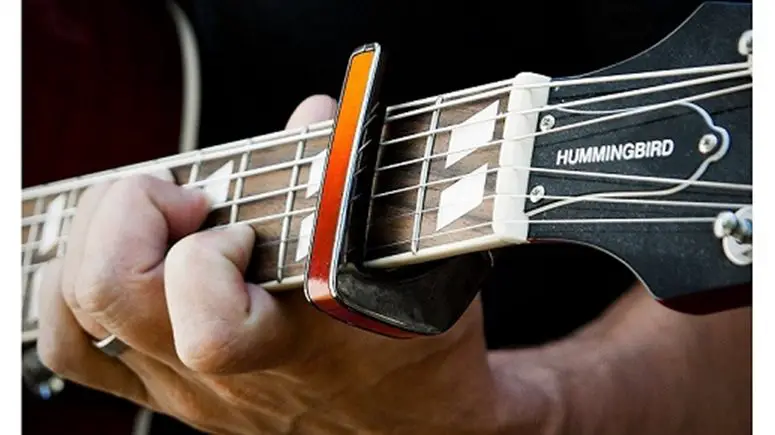 A Guitar Capo is like a clasp that is placed on the strings or on a particular fret of the instrument; it shortens the neck of the guitar and raises the pitch of the key on the guitar; so you can play in a different key using the same fingerings. Most stringed musical instrument players (guitars, banjos, mandolins) use this accessory.
A Guitar Capo is like a clasp that is placed on the strings or on a particular fret of the instrument; it shortens the neck of the guitar and raises the pitch of the key on the guitar; so you can play in a different key using the same fingerings. Most stringed musical instrument players (guitars, banjos, mandolins) use this accessory.
- Ultra Lightweight by xGuitarx: Easy to put on and off within seconds, adjusts to any neck.
- Planet Waves NS Artist Guitar Capo: Adjustable tension, works with most stringed instruments, made of aircraft-grade aluminum, comes with an integrated pick holder
- Kyser Classical Capo: Designed for nylon-stringed classical guitar, if you want one for a regular steel-stringed acoustic, get the ‘Kyser 6-String Capo’ Keyser is a well-known brand.
Guitar Stands (Stands, Wall Mount Hangers)
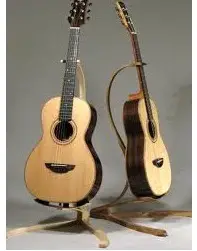 A guitar stand is an accessory to rest your guitar; most of these are height-adjustable to hold various guitar sizes; these have foam rubber padding on the contact points to protect the guitar’s finish. These stands can be dismantled and can be folded for easy storage / portability.
A guitar stand is an accessory to rest your guitar; most of these are height-adjustable to hold various guitar sizes; these have foam rubber padding on the contact points to protect the guitar’s finish. These stands can be dismantled and can be folded for easy storage / portability.
Guitar stands not only saves you floor space by condensing the guitar storage into a smaller area, but it also keeps your guitar ready to be accessed when inspiration strikes or when you feel like practicing.
Unlike a guitar wall mount, which requires you to drill a hole in the wall, stands are ready to use. However, since these rests on the floor, it does take some amount of space, compared to a wall mount.
You also get multi-guitar stands, which really makes it convenient to lay down all your favorite guitars at one place.
You can also choose a wall hanger/wall mount to hold and showcase your guitar.
There are some who feel that a guitar hanger can damage a guitar. However, most guitar stores use hangers to display their guitar collection and wall hangers. The support arms of the mount holds the guitar tightly and securely so there’s no chance of the guitar falling down on the floor (make sure you setup the mount correctly on the wall).
Also, the weight of the guitar body keeps the neck really straight and that helps to get the intonation perfect.
Though the guitar may look good on a guitar hanger on the wall, you may not be able to find a convenient spot. Also, its quite impractical & inconvenient, to hang your guitar on the wall and remove from it, especially if you play a lot and want to access the guitar most of the time.
Stands, on the other hand, stay on the floor, are more practical, and more portable.
- Stageline GS550A wooden acoustic guitar stand
- On Stage XCG4 Black Tripod Guitar Stand
- String Swing’s Hardwood Home & Studio Guitar Hanger
- Guitar Hanger Hook Holder Wall Mount
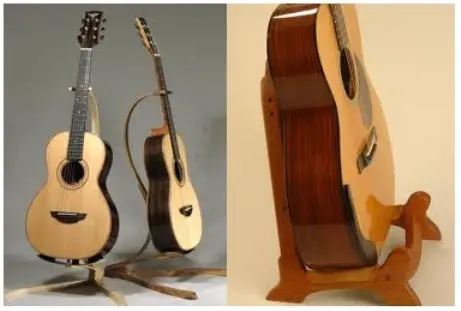
Guitar Seats, Stools, and Chairs
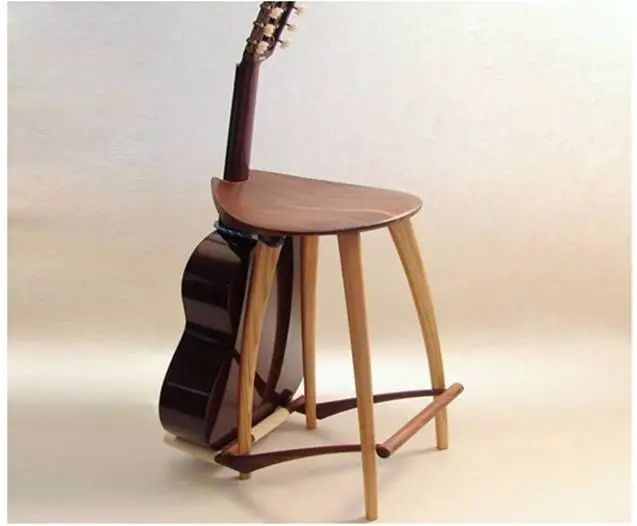 A guitar stool (seat) helps you maintain the right posture while playing, and also keeps you comfortable. Guitar players (classical guitar players in particular) need a guitar stool so that they can sit comfortably and play their axe.
A guitar stool (seat) helps you maintain the right posture while playing, and also keeps you comfortable. Guitar players (classical guitar players in particular) need a guitar stool so that they can sit comfortably and play their axe.
A guitar stool has nice padding, is height adjustable, and some even come with a backrest, which is quite useful when playing the guitar for longer durations.
For most guitar players, a height of around 2-feet high is comfortable (but most guitar stools are height adjustable).
- Pick N Glider Musician’s Chair: Sturdy chair for better posture support. The chair glides smoothly back and forth while playing. The cushions use good quality fabric. The Musician’s Chair is constructed of northern red oak with top-quality upholstery.
- Gator Frameworks Guitar Seat with Backrest: Best value and features. Padded cushion, collapsible, ergonomic backrest and Fold Out Guitar Stand
- On-Stage DT7500 Guitarist Stool with Footrest: All-in-one guitar Stool and stand, Collapsible
- Fender Blackout Barstool: 360-Degree swivel, great for practice or jam sessions
Metronome
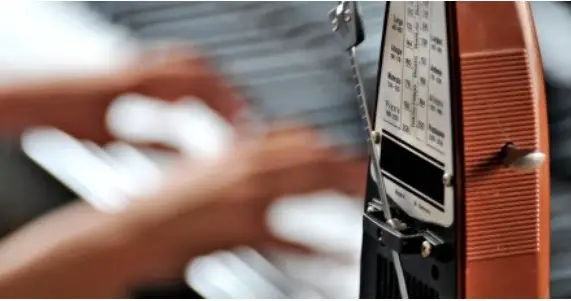 This is a very useful accessory that you need, especially as a beginner. In fact, even if you are experienced I suggest you use a metronome for practicing. It helps you to make sure you’re keeping in time while playing the guitar. Digital metronomes are also available nowadays!
This is a very useful accessory that you need, especially as a beginner. In fact, even if you are experienced I suggest you use a metronome for practicing. It helps you to make sure you’re keeping in time while playing the guitar. Digital metronomes are also available nowadays!
Guitar Strap & Lock
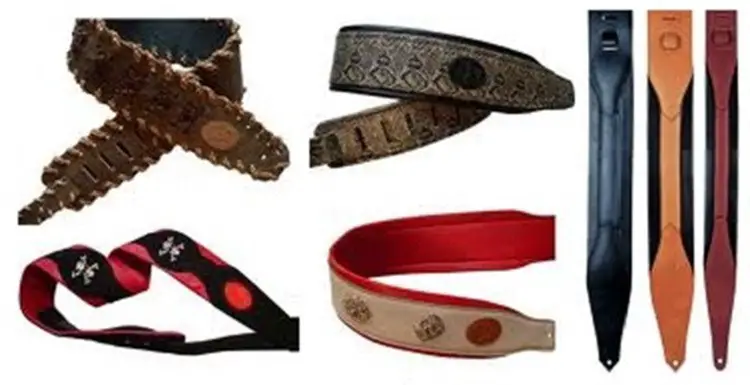 If you are looking for style or something that gives you weight-relief, and to protect your guitar from accidental drops, you need guitar straps and locks.
If you are looking for style or something that gives you weight-relief, and to protect your guitar from accidental drops, you need guitar straps and locks.
A guitar strap has an adjustment system which allows you to adjust their length as per your liking.
You get a wide variety of straps, these are designed not just to be comfortable & durable, but also to be fashionable. You have a selection of leather and fabric guitar straps; You will find simple, elaborate, lightweight, heavy-weight, classy, or even crazy, depending on your comfort.
Here are some more popular choices:
- Protec Guitar Strap with Leather Ends and Pick Pocket
- Levy’s Leathers 2 Jacquard Weave Hootenanny Guitar Strap
- Planet Waves Classic Leather Guitar Strap
- Dunlop Dual Design Straplok System
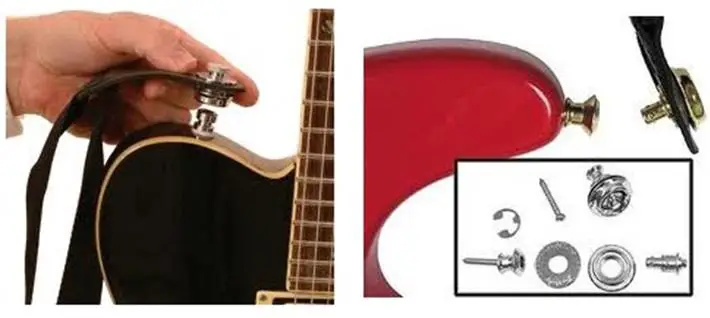 A strap lock helps your prized guitar from accidental falls. A Strap lock is sort of an inexpensive insurance to protect your guitar from falling off onto the floor. These little devices are available for cheap, and once you affix them, you can just play your guitar without worrying about anything.
A strap lock helps your prized guitar from accidental falls. A Strap lock is sort of an inexpensive insurance to protect your guitar from falling off onto the floor. These little devices are available for cheap, and once you affix them, you can just play your guitar without worrying about anything.
How to Attach a Strap to a Guitar
Most guitar straps come with a lace, which needs to be looped through the pinhole at one end of the strap, and tying it around the head-stock of the guitar by the nut under the strings. Once you do that, you can put the pinhole of the other end of the strap over the strap pin of the guitar.
Classical guitars are usually not equipped with any strap pins. You do get straps designed specifically for such guitars.
Here’s a video that shows how to attach an acoustic guitar strap:
Humbuckers
Electric guitar players hate the hum that comes from their amps. Using a guitar without humbuckers, you would hear a slight but noticeable hum from the amplifier during the silent sections of the music. Humbuckers will drastically reduce the hum effect.
Cables
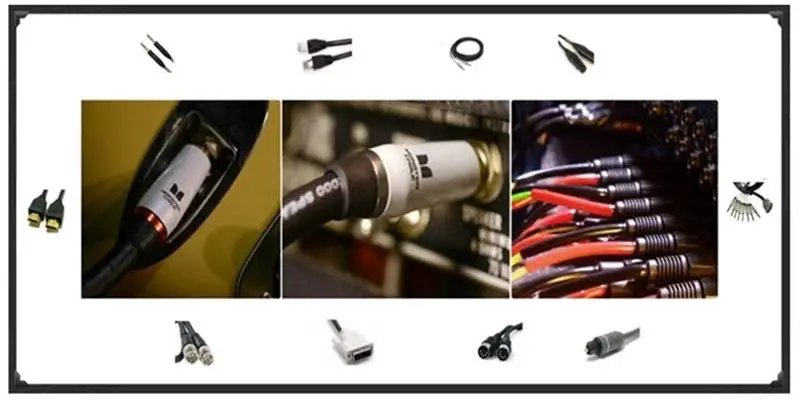 You may have the perfect guitar, the perfect amp and the best pedal board setup but then cables also play an important role in the setup if you want to get a clean sound.
You may have the perfect guitar, the perfect amp and the best pedal board setup but then cables also play an important role in the setup if you want to get a clean sound.
A guitar cable is also referred to as an instrument cable or 1/4″ cable, and its used to to connect your electric guitar (or electric-acoustic guitar) to an amplifier.
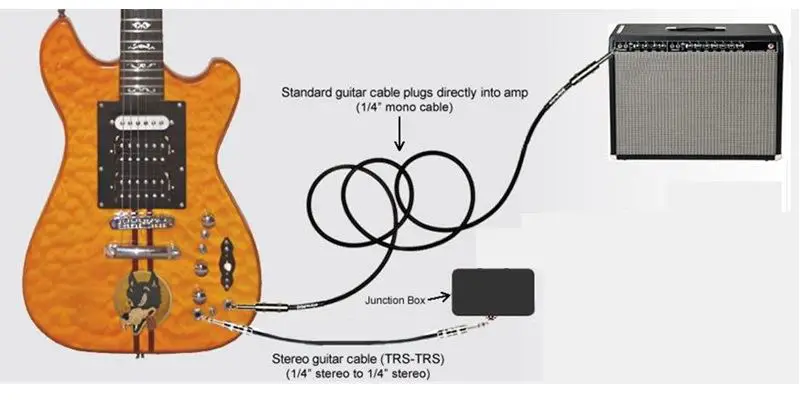
The most common lengths of guitar cables are between ten feet and twenty five feet.
The shorter ones give limited amount of freedom (of movement) to guitarists. The longer ones may look like a better option but cables of over twenty five feet are likely to introduce noise levels into the system and may not give a true representation of the true sound of your guitar.
Better quality cables eliminate noise, and employ shielding techniques that reduce interference from nearby electronics and other music gear.
A patch cable is a short instrument cable. For linking pedals together, get a 6 or 12 inch patch cable to keep your cables as short as possible. If you play with effects pedals, start with as many 12 inch patch cables as you have pedals. Also, get two 15 foot cables to connect the output of your pedal board to the amp and the input of your pedal board to your guitar. This way you distance your pedal board from your amp and distance yourself from your pedal board so that neither your amp of pedal board limit your movement.
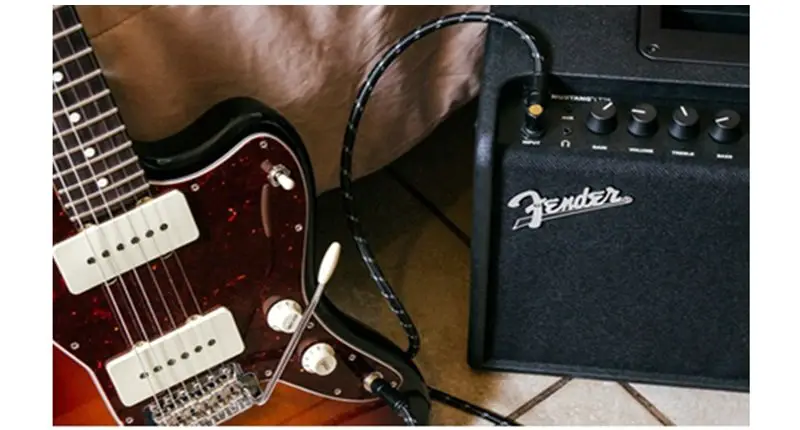
USB Guitar Cable / Interface / Adapter
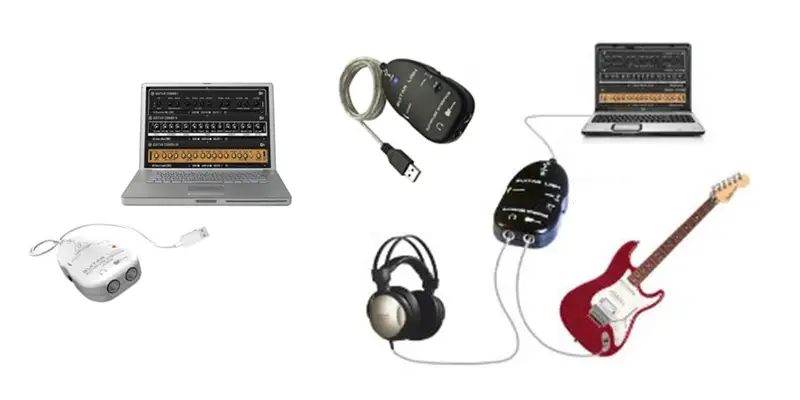 The easiest and cheapest way to start recording with your guitar is to get a guitar-USB interface (a USB Guitar Cable) — a small box that sits between your guitar jack and computer/iPad. You need this to make the connection between your guitar and a computer/iPad. The interface takes the sound from the guitar into the computer, and from there to the speakers/headphones.
The easiest and cheapest way to start recording with your guitar is to get a guitar-USB interface (a USB Guitar Cable) — a small box that sits between your guitar jack and computer/iPad. You need this to make the connection between your guitar and a computer/iPad. The interface takes the sound from the guitar into the computer, and from there to the speakers/headphones.
You need to plug your guitar at one end and connect the other end to a USB port (of the computer). The USB end goes into your computer and the jack-end goes to the amplifier of your guitar. With this setup in place, you are now ready to record your guitar sound into the computer.
If you have a separate sound-card (and a separate pre-amp), you will need to plug the other end of the guitar cable/interface into the pre-amp, the pre-amp’s line output would then go into the audio interface, which would then go into the computer.
Once connected, you can start recording on your favorite DAW recording software. You can even use amp simulators and other effects on your computer to create a better guitar sound.
Here are the best USB options available to guitarists.
You can also use an audio Interface. You can read more on music recording equipment here.
Guitar Effects & Pedals (Pedalboards)
Effects pedal is an important gear in any guitarist’s repertoire; it allows you to transform your sound from ordinary to extraordinary, and are quite useful when playing live or in the studio. Whatever be the genre, effects pedals can bring your guitar’s tone to life.
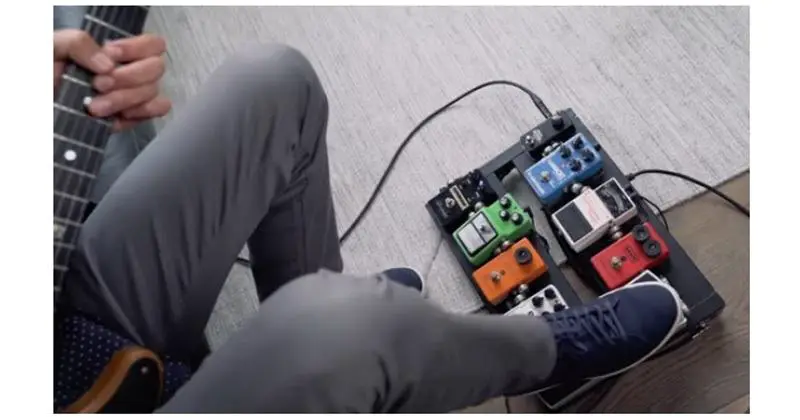
A physical guitar foot pedal can be controlled using your foot while your hands are busy on the guitar.
Most of these effects boxes are triggered using pedals, and hence they are known as Guitar Effects Pedals. Effects pedals are essential gear for any guitarist or bassist.
Common effects units include wah-wah pedals, fuzzboxes and reverb units. Its easy to form an effects chain (or signal chain) by connecting several effects pedals together.
Note: Some guitar players are happy using their guitar amp to provide basic effects like chorus and reverb (which serves the purpose of most musicians).
Effects Units Features
Here are some of the important features of Guitar Effects Pedals.
- Effects units are electronic devices that alter the sounds of a musical instrument and other sound sources.
- The effects can range from subtle to quite dramatic
- These are used in the studio and also for live performances
- Used mostly with electric guitars, bass, and keyboards, and other electric / electronic instruments. However, these can be used with acoustic instruments such as drums and even with vocals
So how does make the connection between the guitar effects pedal, guitar and the amplifier? Usually the connection is made in this manner:
Your Guitar -> Goes to the Effects Pedal -> Goes to the Guitar Amplifier
You need a regular guitar cable to make the connection.
But then you can always add multiple or different guitar effects to make your guitar sound more interesting; which means that the above connection will now follow the sequence:
Your Guitar -> Pedal 1 -> Pedal 2 -> Pedal 3 and so on and the last pedal -> Goes to the Guitar Amplifier
In this case, you use a regular guitar cable to connect your guitar to the first pedal in the chain, and the last pedal in the chain to the amplifier. All the intermediate pedals are connected to each other via ‘patch cords’. A patch cord is a really short cable that is used to cut down the amount of noise that gets added by these pedals.
Here’s a picture that depicts how a guitar effects pedal is connected to a guitar. and the output provided to the amplifier.
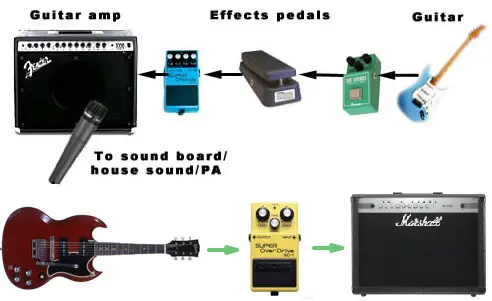
Effects can vary from subtle to dramatic, and come in various types. Here are the more popular ones: Chorus, Phaser, Flanger, Tremolo, Vibrato, Wah-wah, Delay/Echo, Reverb, Overdrive/Distortion, Noise gate, Acoustic Simulator.
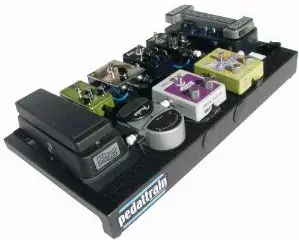
Distortion is an important element of hard rock and metal. Distortion usually is more aggressive than an overdrive, it adds color to a tone and also adds more sustain to a clean channel. You need a distortion pedal for high gain rock and sustains filled leads. Popular distortion pedals are the Wampler Pinnacle Deluxe and the legendary Boss DS-1.
Guitar Delay Pedal: From simple slapbacks, to complex panning delays, to dub-style feedback loops and crazy modulation-type effects, the delay can really make your tone stand apart.
You can also use the delay in conjunction with other effects, but to get best results you should try placing dirt (overdrive, distortion, or fuzz) before delay to get a better sound.
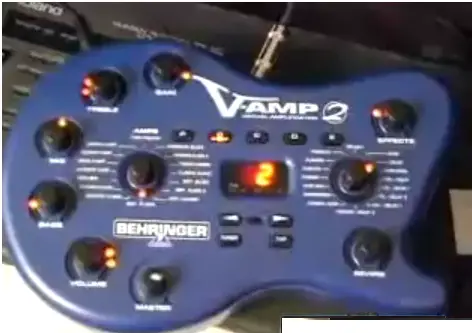
Practice Better
Here are some ideas to use the looping pedal as a guitar practice aid.
- Practice Solos: Record a short chord progressions, and you can then practice solo over them. This is a great guitar practice method for beginners.
- Critique your own playing: You can use the loop pedal (as a recorder) to record your practice/playing and assess how you’re progressing.
- A loop pedal can also store music from favorite recordings, jam tracks or drum rhythm patterns, which can then be used for practice or performance backings.
Watch: One man band using the guitar looper
A Bass pedal, on the other hand, designed to better handle the bass frequencies.
Best Effects Pedals & Pedal-boards
Boss Guitar Effects Pedals
Boss (part of the Roland group) produces some amazing pedals; Boss effects pedals are known for their big footswitches and beefy sound. Boss pedals are also sturdy and designed to stand the test of time, no matter how enthusiastic you are onstage. The chassis is built tougher than the average stompbox, so you can expect it to last for years.
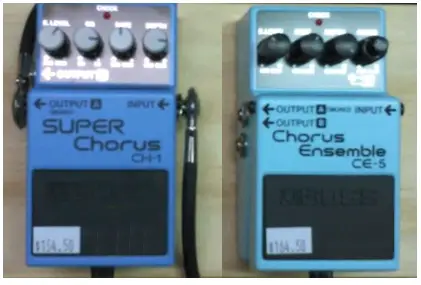
If you’d prefer to mix and match your pedals – Boss has all the basic effects you need, from the TR-2 Tremolo and OD-1X Overdrive to the DS-1 Distortion and CS-3 Compression Sustainer Pedal.
Zoom G1XN Guitar Multi Effects Pedal
Zoom G1XN comes with 8 effect modules and 54 effect types, 80 patches (40 user defined and 40 preset patches), Advanced ZFX-3 processing engine, 96kHz sampling, 24-bit A/D/A Conversion and 32-bit signal processing.
DigiTech RP355 Modeling Guitar Processor
The DigiTech RP355 Modeling Guitar Processor features 126 Amps, Cabinets, Stompboxes and Effects, Built-In wah, whammy and volume pedal, USB Audio Streaming for computer recording, 60 High-Quality drum patterns, and has Built-20 Second Looper.
Boss ME-70 Guitar Multi-Effects Pedal
The Boss ME-70 is a multi-effects unit that comes with 10 types of OD/Distortion, 10 types of Modulation, Reverb, Delay, Compression and Noise Suppressor, and more.

Midi Guitar Pickups
Roland GK-3 Divided Pickup for Guitar
The Roland GK-3 pickup is compact in size, easy to install on any guitar, and turns your guitar into a MIDI controller that can operate any synthesizer or MIDI-enabled device. This pickup easily attaches to any steel-stringed electric (no drilling required) and delivers accurate performance data to guitar synthesizers (GK compatible devices). A “Select Switch” lets you change from synth, to normal guitar tone, or use both of them together.
Buy on zZounds | Buy on Amazon
Fishman TriplePlay Wireless Guitar Controller
It comes equipped with a wireless controller, hexaphonic pickup, and wireless USB receiver, the controller and pickup can be quickly installed or removed on virtually any electric guitar without needing any permanent installation.
Buy on zZounds | Buy on Amazon
Guitar Hard Case
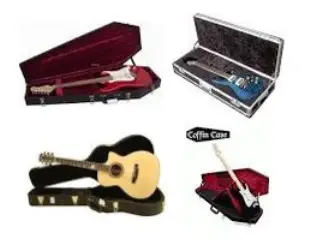 A hard case offers great protection to expensive guitars as these are made from virtually indestructible material (usually rugged military-grade polyethylene) and are designed to handle extreme impact and conditions. These cases come with special safety foam inserts to ensure a snug fit, double anchor industrial grade rivets, industrial latches and spring loaded handles – everything your guitar needs to survive the hazards of transportation. Its a good idea to pad the neck and headstock with bubble wrap (headstock is the most fragile part of a guitar).
A hard case offers great protection to expensive guitars as these are made from virtually indestructible material (usually rugged military-grade polyethylene) and are designed to handle extreme impact and conditions. These cases come with special safety foam inserts to ensure a snug fit, double anchor industrial grade rivets, industrial latches and spring loaded handles – everything your guitar needs to survive the hazards of transportation. Its a good idea to pad the neck and headstock with bubble wrap (headstock is the most fragile part of a guitar).
- Fender Pro Series Stratocaster and Telecaster Case: Buy on Amazon | Buy on zZounds
String Winder and Cutters
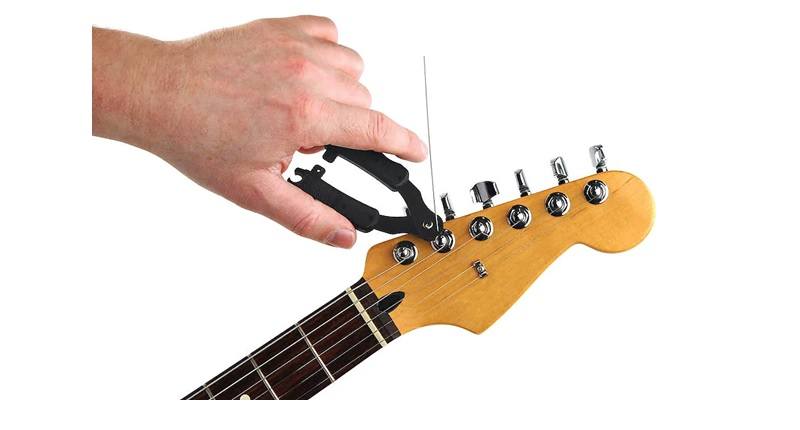 String Winders and cutters make it easy to change strings on instruments like guitars. While not a must-have accessory, a string winder definitely makes an otherwise lengthy task a lot faster and safer.
String Winders and cutters make it easy to change strings on instruments like guitars. While not a must-have accessory, a string winder definitely makes an otherwise lengthy task a lot faster and safer.
Lot of guitar players are able to string or de-string a guitar using only their hands. However, these definitely make the task a lot easier. You need one for your music classroom, rehearsal studio or for your guitar shop.
Not string winders are built alike. I usually prefer and recommend winders that have small or narrow profiles.
Such winders work well on both small as well as regular-sized guitars and other string instruments. And being compact in size, these do not come in contact with adjacent pegs while you’re winding.
Top Guitar String Winders / Cutters:
So, if possible, choose slim designs, especially if you own multiple guitars/instruments.
Humidifiers
Have an expensive acoustic guitar? It might be cheaper to get a humidifier than a crack repair or bridge re-glue. Winters and a dry climate results in cracks and lifted bridges on your acoustic guitar, so you may want to use a humidifier to deal with the problem.

Recommended Accessories
You definitely need a guitar to start learning and to play the guitar. But then there are some guitar accessories which are required as part of regular maintenance, and in general, to make your guitar playing more pleasurable.
To start with you need a pack of nice assorted guitar picks, preferably in a wide variety of thicknesses. You will need a few because it is very easy to misplace these. A pickholder is also recommended to keep all the picks together at one place.
Also consider getting yourself a guitar hanger, perfect for home and studios. These have tubing that ensures there are no marks on the finish of your instrument and these adjustable in width as well.
Another thing that you will need quite often is a set of spare strings. The slinky string set is designed specifically for rock/metal/progressive heavier jam bands/etc. whereas if you own an acoustic guitar you may consider these excellent acoustic guitar strings. To make it easier for you to change the strings, a handy string winder and cutter is recommended.
Over a period of time, guitars go out of tune so you will also need to tune your guitar. You do get some excellent chromatic tuner that comes with a built-in mic / internal vibration sensor to tune your instrument.
From a performance perspective, here is an excellent 6 string capo, one of the most popular quick-release capos around. For practicing your music a guitar stand definitely helps. So consider getting yourself a good guitar stand with a nice leg-locking mechanism.
A Guitar Pickup helps to capture your guitar sounds clearly while performing, especially useful if you play the acoustic guitar. An acoustic guitar pickup nicely secures to the underside of your bridgeplate, inside the guitar.
There are a lot of wannabe guitarists who would want to have a Guitar Strap. It helps to give a nice support since they are easily adjustable and also makes you look like a pro.
KeytarHQ editorial team includes musicians who write and review products for pianists, keyboardists, guitarists & other musicians. KeytarHQ is the best online resource for information on keyboards, pianos, synths, keytars, guitars and music gear for musicians of all abilities, ages and interests.



Leave a Reply